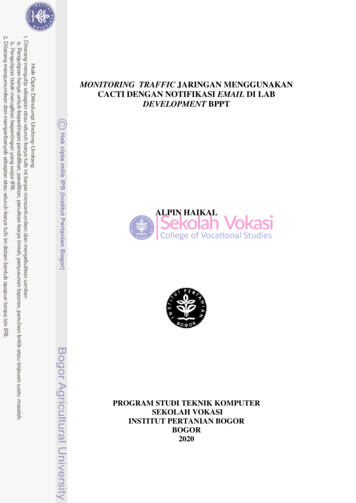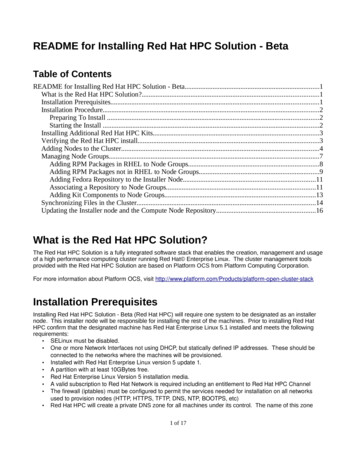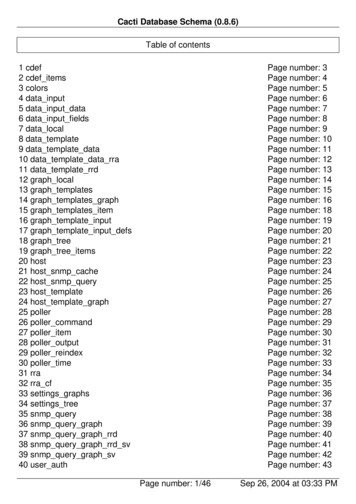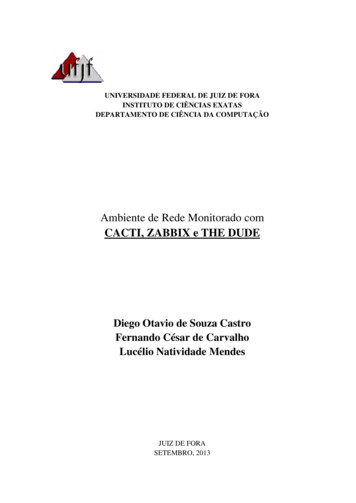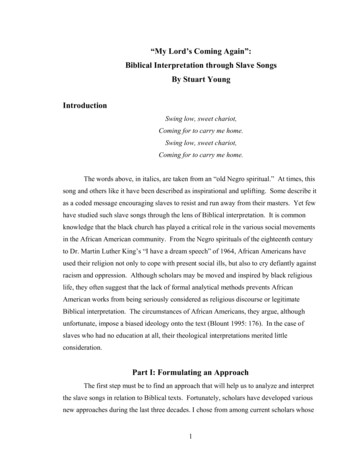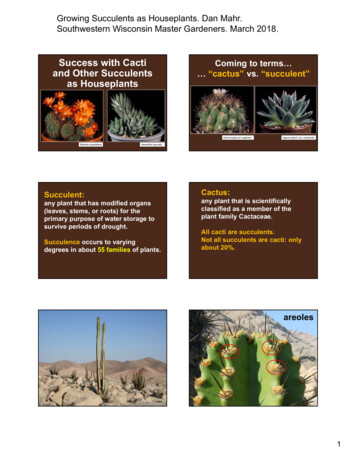
Transcription
Growing Succulents as Houseplants. Dan Mahr.Southwestern Wisconsin Master Gardeners. March 2018.Success with Cactiand Other Succulentsas HouseplantsComing to terms “cactus” vs. “succulent”Gymnocalycium saglioneRebutia donaldianaAgave patonii var. compactaHaworthia baccataSucculent:any plant that has modified organs(leaves, stems, or roots) for theprimary purpose of water storage tosurvive periods of drought.Succulence occurs to varyingdegrees in about 55 families of plants.Cactus:any plant that is scientificallyclassified as a member of theplant family Cactaceae.All cacti are succulents.Not all succulents are cacti: onlyabout 20%.areoles1
Growing Succulents as Houseplants. Dan Mahr.Southwestern Wisconsin Master Gardeners. March 2018.2
Growing Succulents as Houseplants. Dan Mahr.Southwestern Wisconsin Master Gardeners. March 2018.Leaf SucculentsLithops bromfeldiiAdromischus alveolatusStem SucculentsHaworthia schuldtianawhitesloanianaCaralluma socotranaEuphorbia persistensRebutia arenacea3
Growing Succulents as Houseplants. Dan Mahr.Southwestern Wisconsin Master Gardeners. March 2018.Root SucculentsInterrelated Factors for theHealthy Growth of Succulent Plants Light Temperature Air Soil Water Nutrients ContainerBrachystelma pachypodium“caudiciform”plantsFockea edulisInterrelated Factors for theHealthy Growth of Succulent Plants Light Temperature Air Soil Water Nutrients ContainerOthonna cacaloidesLIGHT is the most essential elementfor good growth of succulent plants,but is often the most difficultrequirement to provide.Othonna cacaloidesLithops julii var. fulleriLIGHT: factors to consider: Rebutia heliosa var. heliosaGenerally, the best TEMPERATUREfor growth is 75-90 degrees.IntensityAngleDirectionDuration (photoperiod)Match light to plant needs. Tolerances vary. Some are hardy. Some cacti require acool winter for goodflowering.Artificial lights: intensity isthe key to success.Kalanchoe fedtschenkoiConophytum uvaeforme4
Growing Succulents as Houseplants. Dan Mahr.Southwestern Wisconsin Master Gardeners. March 2018.AIR movement is beneficial;cold drafts are not.SOIL promotes root health andprovides support for the plant.Humidity should below; 40-50% or less.Pachypodium saundersiiPachypodium brevicauleTrichodiadema densumUse a well-drained SOIL MIX. Roughly 50% pottingsoil and 50%drainage material: sponge rock (Perlite) coarse sand poultry grit horticultural pumice Debate over peat. Avoid vermiculite.LandscapegravelBaked clayPoultry gritHorticulturalpumicePerliteEchinocereus triglochidiatusin the Mojave DesertImproper WATERING is therecipe for failure.Aloe erinacea Under-watering results inpoor growth. Over-watering can be adisaster. Water regularly during thegrowing season. Water lightly & infrequentlyduring dormancy. But some plants are wintergrowers!5
Growing Succulents as Houseplants. Dan Mahr.Southwestern Wisconsin Master Gardeners. March 2018.OVER-WATERING can result inroot rot and loss of plant. Rebutia albifloraWell-drained soil mix.Good root-to-soil ratio.Appropriate sized pot.Active growth andwarm, sunny weatherresult in rapidevapotranspiration.Golden Rules of Watering: If at all moist, don’t. If in doubt, don’t.The CONTAINER is the framefor your painting. NUTRIENTS are required forhealthy plants and flowering.Avonia quinaria var. alstonii( Anacampseros alstonii)Secondary Considerations for theHealthy Growth of Succulent Plants Repotting. Recognizing growthperiods. Pests and diseases. Migrating plants. Sources of plants. More information.Porous vs. non-porous.Shallow vs. deep.Square vs. round.Utilitarian vs. aesthetic. MUST have drain holes.DO NOT over-pot; balancepot size with root system. Most succulents live innitrogen-poor soils. Use 1/4-1/2 strengthsoluble houseplantfertilizers. Fertilize only duringactive growth periods. High phosphorousfertilizers promoteflowering and healthyroots.Adenia glaucaRebutia verticillacantha var.albispinaREPOTTING should normallybe done every 2-3 years. Disocactus flagelliformisWhen REPOTTING: Inspect roots. If necessary, allowroots to dry. Use slightly damp soil. Do not water for 7-10days after repotting;then water cautiouslyfor first month.Better growth.Promotes root health.Replenishes nutrients.Improves soil structure.Removes salts.Repot at the beginning ofthe growing season.Astrophytum capricorne6
Growing Succulents as Houseplants. Dan Mahr.Southwestern Wisconsin Master Gardeners. March 2018.Not all succulents have thesame GROWTH PERIODS.Cacti and succulents are notimmune to PESTS and DISEASES. Most grow in summer. Some grow in springand/or fall. A few are wintergrowers. Some are opportunists.Pelargonium rapaceumMealybugs.Spider mites.Whiteflies.Aphids.Root rots.Stem rots.Viruses.Physiological diseases.“The blahs” (check theroots!).Aloe jacksoniMIGRATING PLANTSEchinocereus pentalophusCheck forhitchhikers! Plants can be winteredindoors and spend thesummer in the sun. When moving out,expose to full sungradually. When outside, protectfrom prolonged cool,wet weather. When in for the winter,provide as much lightas possible.SOURCES of PLANTSSOURCES: How to pick a healthy plant. Garden centers.Chain stores.Friends.Specialist mail-ordernurseries. e-bay. Web sites:www.cactus-mall.com/Dorstenia foetidaBut please don’tdig up the desert! Avoid gimmicks.Has it had good light?Uniform shape.Uniform color.Avoid scarred plants.Is it well rooted?Check for pests.Notocactus sp.7
Growing Succulents as Houseplants. Dan Mahr.Southwestern Wisconsin Master Gardeners. March 2018.Plants That Can Tolerate Lower LightPlants That Can Tolerate Lower LightMostly Small Species That Live Under ShrubsMostly Small Species That Live Under ShrubsCacti SucculentsRebutiaGymnocalyciumLobiviaMammillaria Haworthia starkianaHaworthiaGasteriaSmall AloesSansevieriaMadagascarEuphorbiasGasteria ellaphieaeLobivia tiegeliana var. pusillaMORE INFORMATION WORDS OF CAUTION!Books.Journals.Societies.Nurseries.The web.Euphorbia persistensEuphorbia obesaMany cacti and othersucculents havefierce spines orhighly toxicchemicals to protectthemselves frompredation.Use caution whenhandling plants, andprotect children andpets.Enjoy your plants!Rebutia senilis8
Many cacti and other succulents have fierce spines or highly toxic chemicals to protect themselves from predation. Use caution when handling plants, and protect children and Euphorbia obesa pets. Enjoy your plants! Rebutia senilis. Title: Microsoft PowerPoint - GrowingSuccs-entire-2018.ppt [Compatibility Mode]

